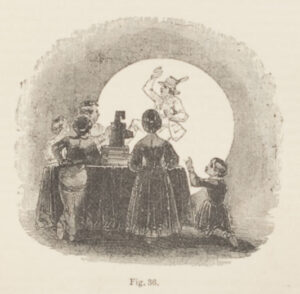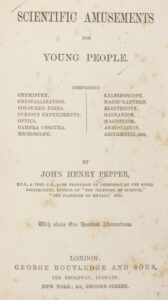Published: London, ca. 1868
In mid-19th-century Britain, as the Industrial Revolution flourished and the empire prospered, popularized science and natural history became increasingly favored forms of entertainment for the growing middle classes. National  museums, world’s fairs and expositions, and public lectures and demonstrations showed off imperial spoils as well as sharing “useful knowledge” and the output of the emerging scientific professions.
museums, world’s fairs and expositions, and public lectures and demonstrations showed off imperial spoils as well as sharing “useful knowledge” and the output of the emerging scientific professions.
At the same time, children’s literature was taking off to meet growing demand for educational material. Publishers like Routledge rose to meet this demand, producing such books as Papers for Thoughtful Girls, Jabez Hogg on the Microscope, Rev. J.G. Wood’s Our Garden Friends and Foes, and this small volume by John Henry Pepper.
In a fashion similar to publications like Boys’ Own Magazine and The Boy’s Journal in the 1850s and 1860s, this book describes home experiments for kids’ fun and edification. With “above One Hundred Illustrations,” Pepper instructs his readers on experiments about “Sounds obtained by burning Hydrogen under Glass Tubes” and “Sparks Drawn from the Nose” (which is just what it sounds like) and shows how “To Melt a Coin in a Nut-shell” and “To make Magnets with Poker and Tongs.” Pepper introduces the book with a cautionary tale about a little boy whose face got in the way of a mortar filled with exploding phosphorus and chlorate of potash (“juvenile philosophers” should “avoid those results that merely end in explosions”). Nonetheless, one doubts that kits based on many of his suggested experiments would make it past the Consumer Product Safety Commission today.
 This was not John Henry Pepper’s only effort to bring science to the people or, more specifically, to youngsters. He also wrote The Boy’s Playbook of Science, among others, and he ran classes and delivered lectures with demonstrations of experiments, illusions, and magic-lantern displays. Pepper is also noted for perfecting and popularizing an apparatus that created the illusion of a spectral figure of an actor, a technique known as “Pepper’s ghost.”
This was not John Henry Pepper’s only effort to bring science to the people or, more specifically, to youngsters. He also wrote The Boy’s Playbook of Science, among others, and he ran classes and delivered lectures with demonstrations of experiments, illusions, and magic-lantern displays. Pepper is also noted for perfecting and popularizing an apparatus that created the illusion of a spectral figure of an actor, a technique known as “Pepper’s ghost.”

